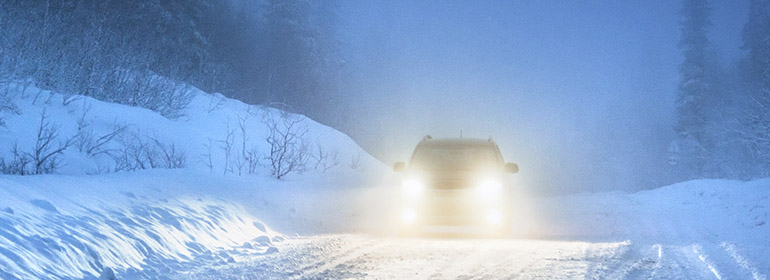
Top Tips For Driving in Winter
Posted on January 22, 2019
Winter is on the way, and will bring the likely event of difficult driving conditions. Winter requires all drivers, whether personal or business related, to take more care and be well prepared for all conditions.
Further to our vehicle safety tips article. Here is some more information about keeping safe on the roads in the adverse weather.
Choose the right gear
Once you’ve prepped your car, and you’re driving in the cold weather; if there is ice and snow on the road, say goodbye to first gear.
When you’re driving in slippy conditions, pulling away in second gear will help with your traction and reduce the potential for wheel spin.
Accelerate gently
Accelerating rapidly is a surefire way to get out of control in the icy cold. So accelerating slowly, sensibly and gently gives you far more chance of maintaining control and staying safe.
Stay well back
Stopping distances increase in the ice and snow, so make sure you leave more room behind the far in front than you usually would.
Consider winter tyres/snow socks
Most British cars are installed with summer tyres and most of us don’t change over in the winter. However, if we have a cold period like we did last winter, considering how to get greater grip could well be wise. Winter tyres will give you more grip. But if you don’t want to go the whole hog, it’s worth considering snow socks which fit over your summer tyres.
Leave more time for each journey
A lot of accidents in the winter are caused by people driving inappropriately given the conditions. Leaving more time for your journey will ensure you don’t rush and put yourself, your passengers and other drivers at risk.
Be careful as the weather changes!
Television and radio often carry warnings that you should not drive “unless it is absolutely necessary”. And we certainly should not ignore this advice. However, there are, of course, times when driving is absolutely necessary. In many cases, for drivers of commercial vehicles, company business will insist that the journey is made.
Health and Safety professionals will be aware that driving is the most hazardous task many employees perform, in any conditions. Add into that icy roads, strong winds or restricted visibility, and employees face many risks. But there are ways to ensure drivers remain safe when your organisation sends them onto the roads.
Be prepared
One of the most important factors behind a safe journey is being prepared. Employers can play a big part in making sure vehicle users are prepared for their journey. In good and bad weather. The HSE has advice on ways this can be done. Firstly, employers can liaise with drivers in assessing whether a journey is needed.
Even a business journey can be cancelled if the weather is severe. A journey cancellation enforced by bad weather can prevent an employee from being involved in an accident and requiring time off work. The health and safety of employees is of vital importance to a company. So cancelling can save money and time in the long run.
Equally, companies should ensure that drivers do not feel forced to complete journeys when weather conditions are too severe. Having a culture whereby drivers know they will not be in trouble if they judge the conditions are too dangerous helps to facilitate safety. It is also helpful to check that drivers know who they should contact if they have to cancel a journey.
If it has been decided that the weather is not severe enough to prevent the employee from making a journey, then employers can provide advice to drivers on staying safe. Such as assessing whether journey times and routes can be adjusted to take account of the conditions. Employers should always know which routes their drivers are taking.
Check the Vehicles Capabilities
Health and Safety professionals within an organisation can also assist by checking that the vehicles used are capable for the conditions. Examples include making sure they have anti-lock brakes, and appropriate tyres which had a good depth of tread.
In bad conditions, vehicles should have at least 3mm tread on their tyres and air pressure in line with the manufacturers’ recommendations. Supervisors should also check that the windscreen washer fluid is of the correct strength for freezing conditions.
Other vehicle checks which can be made include:
- Ensure lights are working and are clean and snow free.
- Make sure that the vehicle windscreen is fully clear of ice and snow.
- Before setting off, a driver should ensure windows are demisted.
- To prevent snow sliding down the windscreen it should be cleared off of the vehicle roof.
- The driver should ensure that the vehicle battery is in a good condition.
- Listen to weather forecasts and travel bulletins.
- Keep an ice scraper and de-icer in the vehicle.
While the driver has the ultimate responsibility for these steps, health and safety managers are in a position to provide reminders, advice and training, so it is worthwhile considering these factors.
Safety first: Snow & Ice
There are many tips which can be passed on to drivers in snowy and icy conditions. Drivers need to be reminded that when conditions are snowy and icy, stopping distances are ten times greater than in good conditions.
Drivers should modify their driving technique in severe weather. One tip is to choose the correct gear (normally second) to pull away from a standstill to avoid wheel spin. When driving uphill, drivers should ensure they have enough clear road to drive up the hill without stopping if possible, and avoid changing down gears.
When driving downhill, it’s important for drivers to leave as much room as possible between them and the vehicle in front; they should also drive in low gear and try to avoid using their brakes. If drivers do need to use their brakes, they should go gently and de-clutch if the vehicle skids.
Other Useful Reminders
- Footwear should be dry and provide enough grip to avoid “pedal slip”.
- Avoid sudden vehicle movements as these can cause loss of vehicle control.
- If your vehicle skids, take your foot off the accelerator and point the vehicle in the direction you want to go.
- If you have an automatic gear box, if possible select “2” in order to avoid first gear.
- Consider other road users: if you can safely stop prior to your descent to allow other road users to climb more safely, do so.
- Brake smoothly and gently, slow down slower than usual on the straight before you take a corner and gently accelerate once you have left the bend.
- Keep the vehicle ventilated so the hot air from the heater doesn’t make you drowsy.
- Use dipped headlights if the visibility is poor.
- Be aware of icy patches under bridges and tree-lined sections of road.
- Refrain from over-taking vehicles if the weather deteriorates.
- Remember that when driving on ice, tyres hardly make any noise.
Other forms of bad weather
Of course, snow and ice isn’t the only form of bad weather that company drivers, and health and safety managers, need to be aware of. With rain, stopping distances are twice as great as on dry roads. It is also advisable to plan ahead and make sure that vehicles are in good condition. When roads get flooded, drivers should avoid the deepest water near the kerb. If the water appears too deep, an alternative route should be found. If drivers do hit standing water, they should always check their brakes afterwards.
Strong Winds
When the winter conditions include strong winds. Drivers should remember that cyclists and motorcyclists can be blown off course. So you should leave more space than usual between them and any one on two wheels. They should also be aware that high sided vehicles caught in high winds may well lose control in sudden gusts.
In addition, bridges and high buildings can alter wind movements. When driving in fog, dipped headlights should be used. However, fog lights should only be used when visibility is reduced to less than 100m. It’s worth remembering that when it looks like fog is clearing, you can suddenly hit another fog bank.
Low Sun
Another risk to consider when driving in the winter is the sun, which is low during winter months. Keeping the inside and outside of your windscreen clean and free of smears will reduce the effect of glare. If you have stubborn smears on the windscreen, try using dissolved dish washer powder in water or a cream-type glass cleaner with clean kitchen roll. The last point to remember is to simply reduce your speed and turn on your lights so you can be seen. While drivers do have a responsibility to be safe on the roads, health and safety professionals can take action to facilitate this, including reminders and training.
Up to date information on weather conditions can be found on the Met Office website: http://www.metoffice.gov.uk/
If you have any tips to share, tweet us: @CourtleyHS
Don’t hesitate to contact us at the office (0151 545 0497; [email protected]) if you have any concerns.
